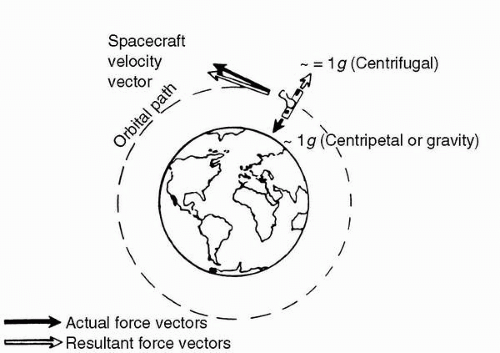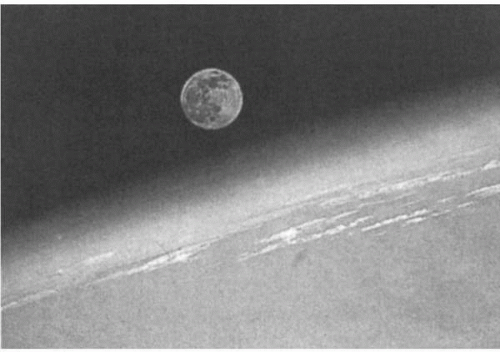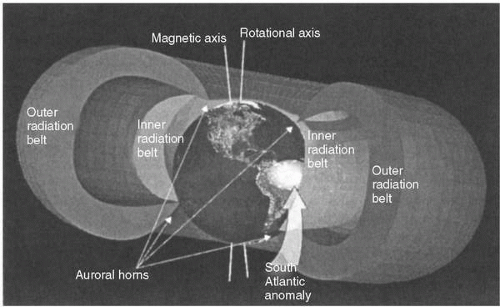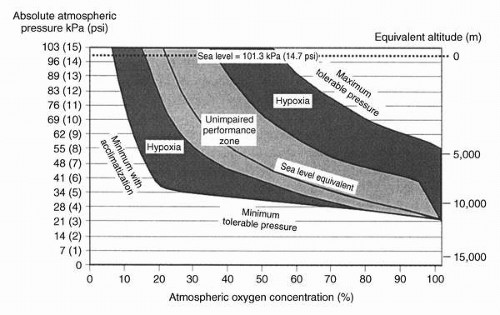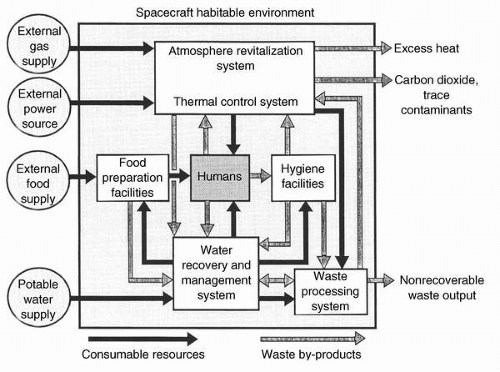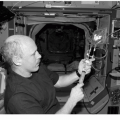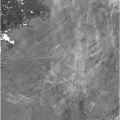The space environment is markedly different from that found on the Earth’s surface and is not habitable, primarily because it lacks an appropriate gaseous atmosphere. However, there are other environmental characteristics that define the space environment that can also significantly affect human survival.
Lack of Atmosphere
Earth’s atmosphere consists of a combination of temperature, pressure, and gas composition necessary for human survival on the planet’s surface. The vast majority of the gas molecules that comprise the atmosphere are within 10,000 m of the surface. As distance from the surface increases, the number of atmospheric gas molecules per unit volume decreases and the number of collisions between individual gas particles decreases, causing atmospheric pressure to fall.
Figure 10-1 illustrates the thinning of the atmosphere away from the Earth’s surface.
There are other key physiologic and engineering constraints that occur at specific altitudes within the atmosphere. Pressurized oxygen delivery masks are ineffective above altitudes of 13,000 m (43,000 ft), making cabin atmospheric pressurization necessary (see
Chapter 3). Above 18,900 m (63,000 ft), the total atmospheric pressure equals the vapor pressure of water at body temperature. It is above this altitude, known as
Armstrong’s line, that the bodily fluids of an unprotected individual would spontaneously boil in a process known as
ebullism. Above 27,000 m (90,000 ft), the atmosphere becomes too thin to support current air-breathing jet engines requiring the use of rocket motors. At altitudes above approximately 90
km (47 mi), the atmosphere is too thin to allow the use of aerodynamic control surfaces, necessitating the use of reaction motors to control the orientation of a vehicle. This is known as the
Von Karmann line. Above altitudes of 180 to 200
km, air resistance becomes negligible, marking the true engineering boundary between the atmosphere and space. The upper limit of the atmosphere is defined as the point at which collisions between molecules become immeasurably infrequent (˜700
km). Above this is the hard vacuum of true space, known as the
exosphere, where the number of air molecules thins to a density of approximately 1 to 20 mol/cm
3.
Altered Gravity Environments
The force of gravity is a fact of life on Earth. Humans traveling to space from Earth, traveling in space, and returning to Earth can expect to experience significant alterations in gravitational effects. At the Earth’s surface, the mass of the planet exerts gravitational force equal to 9.81
m/s2 (32 ft/s
2). This gravitational field extends for millions of kilometers beyond the surface (the Moon is trapped within this gravitational field). However, placing a spacecraft in orbit can counterbalance this gravity field, allowing the vehicle to remain in space (
Figure 10-2). The speed of the vehicle must be sufficient to generate centrifugal force equal in magnitude to the planet’s gravitational force at that altitude. When this is done, the vehicle will not fall back toward the surface. In other words, an orbiting object is continuously falling around the planet, although its tangential velocity prevents it from falling closer to the surface. This balancing of centrifugal and gravitational force vectors simulates the lack of true gravity, and is more properly referred to as
free fall or
microgravity.The magnitude of the planet’s gravitational field determines how fast an object must travel to achieve orbit. Spacecraft in
LEO at altitudes of 250 to 600
km (150-350 mi) must maintain tangential velocities of 28,000 to 42,000 kph (17,000-25,000 mph). Conceivably, objects could orbit at lower altitudes, but aerodynamic friction from the Earth’s atmosphere precludes this. Smaller planets exert less gravitational force, so the velocity required to reach orbit is less. Orbital velocities around Mars (where the surface gravity is one third as strong as Earth’s) and the Moon (where the surface gravity is one fifth of Earth’s) are much lower at comparable altitudes.
Microgravity significantly affects the habitability of space because humans are naturally adapted to the gravity of the terrestrial environment. Before the first human spaceflights proved them wrong, some scientists were worried that humans could not live without gravity (
1). Microgravity does affect human health, from the immediate effects of motion sickness and possible alterations to gastrointestinal functioning to the long-term effects of bone demineralization. Further discussion of the medical risks of microgravity is addressed in
Chapter 28.
As noted earlier, traveling to space using current rocket technology requires reaching orbital velocities. To return from space, spacecraft must lose velocity by using the Earth’s atmosphere as a brake. These large changes in velocity impose significant acceleration and deceleration forces on spacecraft and their inhabitants. Mercury astronauts experienced acceleration forces of up to 8 G
x (chest to back) for short periods of time (
2). In contrast, shuttle passengers now experience a maximum of 3 G
x during launch. During reentry, Soyuz passengers can experience up to 10 G
x. Shuttle passengers experience lower forces (1.3 G
y), but for longer duration, and in a different orientation (head to foot).
Changing a spacecraft’s linear or rotational velocity while in space also subjects passengers to acceleration forces.
Gravitational forces can also be simulated by centrifugal force caused by rotating a spacecraft about its axis. In the future, rotating spacecraft might have the pseudogravity of centrifugal force to mitigate the adverse effects of weightlessness.
Orbital Mechanics
Although a detailed discussion of orbital mechanics is beyond the scope of this text, an explanation of basic orbital nomenclature illustrates the impact of orbital mechanics on spacecraft operations. Orbital mechanics play an important role in the capability of launching payloads into orbit. As shall be seen, orbital mechanics also play a central role in determining the radiation exposure a spacecraft receives.
While launching a rocket into Earth orbit, the angle of the launch vector with regard to the equator defines how much acceleration is needed to reach the orbit and hence how much payload can be lifted into it. This is because the Earth’s rotation profoundly influences what orbits are achievable. The tangential velocity of the Earth’s surface is greatest at the equator (1,040 mph or 1,734
km/hr), and drops off to zero at the Earth’s poles. When launching a rocket in an eastward direction, the rotational velocity of the Earth can be applied to the amount of velocity needed to reach orbit. The lower the latitude, or more southerly the launch site is, the greater the available rotational velocity is and the less rocket propellant will be required. Attaining orbit is most efficient at the equator and most difficult at the poles. Changing the angle of the launch vector changes the angle of inclination of the resultant orbit. Orbits are typically referred to by this angle of inclination. Launching a vehicle due eastward from the equator would give an orbital inclination of 0 degrees. From any given launch site, the most efficient possible orbital inclination is equal to the latitude of the launch site. Therefore, a rocket launched due eastward from Kennedy Space Center in Florida will enter a 28-degree orbit, and a vehicle launched eastward from the Baikonur launch site in Kazakhstan will have an orbital inclination of 51.6 degrees. Any rocket launched from the Earth’s pole will have a 90-degree inclination. Orbits of different inclination can be achieved from a given launch site by shifting the launch vector northward or southward from due east, but this comes at the expense of significant increases in the amount of propellant required to reach orbit. Therefore, a space shuttle launched from Kennedy Space Center to the
ISS (which is in a 51.6-degree orbit) can carry much less payload than if it were launched into a 28-degree orbit. Launching a rocket westward requires extrapropellant to counteract the Earth’s rotation, making such orbits prohibitively inefficient.
Radiation
The space environment is relatively devoid of matter, but it can be full of energy, especially in the vicinity of a sun such as ours. This energy comes in the form of electromagnetic radiation and high-energy particles. The electromagnetic radiation found in space is of many wavelengths, from low-frequency microwave radiation and below to infrared (heat), visible light, and ultraviolet wavelengths and all the way to high-frequency x-ray radiation and
γ radiation and beyond. Particles such as protons, electrons, neutrons,
α particles, and heavy ions may be of inconsequential mass but can be highly energetic. The Earth’s atmosphere and surrounding geomagnetic field partially shield the planet’s surface from space radiation. During spaceflight outside of
LEO, spacecraft can leave this protective envelope, increasing the risk of exposure of the passengers to potentially harmful radiation.
Ionizing versus Nonionizing Radiation
Particle and electromagnetic radiation can be grouped and classified as either ionizing or nonionizing radiation. Ionizing radiation has sufficient energy to knock material from atomic structures during a collision, which can release further electromagnetic or particle radiation. Astronauts have reported that, when their eyes are closed, they occasionally see small flashes of light, evidence that the energetic products of nuclear collisions occurring within the eye can activate retinal visual receptor cells (
3). If ionizing radiation particles collide with atomic nuclei inside human cells, the resultant energy release can damage cellular DNA. This genetic damage can lead to cell death or the cellular mutation that underlies carcinogenesis.
Nonionizing electromagnetic radiation may not be energetic enough to directly damage genetic material, but it can still be quite harmful. Solar ultraviolet electromagnetic radiation, unattenuated by the atmosphere, can cause severe sunburn and retinal burns after only seconds of exposure. Solar infrared radiations that can cause significant thermal loading, are discussed later.
Ionizing radiation comes from several sources: galactic cosmic radiation (
GCR), solar radiation, and geomagnetically trapped radiation. Because the altitude and trajectory of a spacecraft’s flight affect the amount of radiation received from these sources, this information is used to calculate projected radiation dose profiles that are used during mission planning.
Galactic Cosmic Radiation
GCR is radiation that originates outside of the solar system and is probably generated by the cataclysmic extrasolar events such as supernovae.
GCR is predominantly particle radiation, consisting of
α particles,
β particles, and the heavier nuclei such as tin or lithium. These particles often travel at tremendous velocities, imparting them with very high energy usually in the range of 0.3 to 2 GeV (10
9 eV). Although there is a relatively constant flux of
GCR into the solar system, the amount of
GCR in the region of planetary bodies is influenced by solar activity. Because planetary magnetic field strength increases during periods of high solar activity, scattering of charged
GCR charged particles away from the planetary environment is maximal during these periods, thereby decreasing the amount of
GCR that penetrates the geomagnetic belts.
Although they can be diverted by electromagnetic fields, the high velocities of galactic charged particles allow them to penetrate through meters of solid matter, making passive shielding (e.g., the aluminum walls of the spacecraft) essentially useless. Fortunately, its high velocity and low flux density makes it likely that
GCR will pass through an astronaut without striking any atomic nuclei, yielding minimal energy transfer to the cellular components. Increased amounts of passive shielding increases the likelihood that
GCR particles will collide with nuclei within the shield. These nuclear collisions may release a shower of secondary electromagnetic radiation and high-energy particles (usually neutrons) that may have more adverse biologic effects than the original particles (
4).
Solar Wind and Solar Cosmic Radiation
The solar wind consists of proton-electron plasma that is ejected from sun at velocities of 400 to 500
km/s (240-300 mi/s). This solar wind or solar cosmic radiation (SCR) is the most variable portion of the background space radiation and changes density considerably during the Sun’s 11-year cycle of activity. During periods of high solar activity, SCR can be the major source of the astronaut’s space radiation exposure, especially when the solar particles become trapped in the Earth’s geomagnetic belts. In periods of minimal solar activity, the trapped radiation belts are not as energized, and
GCR becomes the predominant source of exposure. Solar flares can cause a 1,000-fold increase in the radiation flux of the SCR in the form of solar particle events (
SPEs).
Solar Flares and Solar Particle Event Radiation
Magnetic disturbances on the Sun’s surface can lead to solar flares, which consist of electromagnetic radiation, as well as
SPEs that consist of high-energy protons. The
SPEs can contain particles of sufficient energy and flux density to result in a lethal radiation exposure to an unshielded space traveler unfortunate enough to be caught within it (
5). Fortunately, the particle radiation released during such events is not uniformly distributed in all directions, so not every SPE will expose a spacecraft in a given location to the maximum flux of radiation emitted. The rate of onset and rate of dissipation of an SPE radiation flux density can also be quite variable and can vary in duration from minutes to days.
SPEs typically occur during the active period of the solar cycle.
Unfortunately, it is very difficult to predict exactly when an SPE might occur, as well as the duration and flux of the radiation that the SPE will produce and how significant a spacecraft’s exposure to that radiation will be. Radiation detectors orbiting the Earth can measure the increases in solar electromagnetic radiation that accompany solar flares, and other devices can detect increases in proton flux density. Detection of significant increases in electromagnetic and particle radiation indicate that an SPE may be occurring. Spacecraft may then be alerted, so that crewmembers can conceivably take shelter in a shielded “safe haven” until the radiation flux returns to acceptably low levels (
6).
The Earth’s magnetic field is an effective shield against even the most massive
SPEs. The radiation contained by the largest SPE ever recorded (August 1972) would have been undetectably low to a space shuttle traveling in a typical orbit under the Earth’s magnetosphere; however, it could have posed a health hazard to an inadequately shielded spacecraft traveling in a higher orbit.
Magnetically Trapped Radiation
The size and nature of the Earth’s geomagnetosphere was examined by Dr. James Van Allen and his team in the 1950s. Generated by the rotation of the Earth’s molten ferromagnetic core, the Van Allen belts are toroidal structures that encircle the planet in an extremely powerful magnetic field. The thickness of these geomagnetic belts depends on the latitude, the thickest portion being near the equator. Note that the Earth’s magnetic pole is slightly offset from its rotational pole. Instead of striking the Earth’s surface, the high-energy particles of
GCR and the solar wind become trapped within these magnetic belts, oscillating along the lines of magnetic force. The amount of trapped particles in these belts increases during periods of high solar activity.
The Van Allen belts are compromised of two layers, an inner belt (extending from altitudes of 300-1,200
km) that contains trapped protons and heavy ions and an electron-containing outer belt (extending from altitudes of ˜10,000
km to altitudes of more than 55,000
km, depending on the solar wind). Because of their toroidal shape, the magnetic fields of the Van Allen belts can lie close to the outer surface of the atmosphere at extreme northern or southern latitudes. (These low-lying regions are known as the
auroral horns.) This is illustrated in
Figure 10-3. At extreme latitudes, impact of trapped high-energy particles with the atmosphere can ionize the atmospheric gas molecules, causing the spectacular light shows of the Arctic Aurora Borealis and Antarctic Aurora Australis.
Most orbital flights occur at altitudes below the majority of the volume of these magnetic belts, providing some protection to spacecraft occupants from space radiation. However, because the rotational axis of the Earth does not coincide with its magnetic pole, this discrepancy causes the magnetic belts to dip to altitudes as low as 160 to 320
km (95-215 mi) in the region known as the
South Atlantic anomaly (SAA). Orbiting spacecraft passing through this region are exposed to particle radiation trapped within the magnetic field that is equal in intensity to radiation found at altitudes of 1,300
km (750 mi). Most radiation received during shuttle missions with typical low-inclination orbits (28 degrees) occurs as a result of passing through this zone. The percentage of orbits that pass through the SAA depends on the angle of inclination. The higher inclination (51.6 degrees) orbit of
ISS pass through the center of the anomaly less frequently than 28-degree low-inclination orbits. However, because the size of the anomaly increases at higher altitudes, a spacecraft orbiting at high altitude (e.g.,
ISS) will be exposed to more radiation than a spacecraft traveling along the same orbital track at a lower altitude.
Also, high-inclination orbits pass through the auroral horns, where the geomagnetic belts dip closer to the surface, thereby increasing exposure to trapped belt radiation. Because the geomagnetosphere does not cover the Earth in polar regions, spacecraft traveling in very high-inclination orbits are also exposed to a higher dose of
GCR.
Radiation on the Moon and Mars
Because it lacks both an atmosphere and a geomagnetic field, the Moon’s surface is not shielded from radiation as Earth’s surface is. The lunar surface, composed of rock and powdered debris from meteor impacts (
regolith), is therefore subjected to steady bombardment by
GCR and solar radiation, including the occasional SPE. Mars also lacks a significant geomagnetic field, but its thin atmosphere of carbon dioxide does provide some radiation shielding. Because a planet’s spherical mass shields a given point on its surface from a geometrical proportion of cosmic radiation (this is known as 2
π shielding), the radiation experienced on the surface of these bodies is roughly half of what would be experienced in similar regions of free space. Planetary materials can also be used as radiation shielding. If an inhabited lunar station were established, covering it with a thick coating of
regolith could serve as an effective radiation shield for everything except high-energy protons and neutrons (
7). However, if the
regolith coating were insufficiently thick, secondary radiation scattering from nuclear collisions within the layer could paradoxically worsen the radiation exposure to the crewmembers beneath it.
Thermal Instability
The Earth’s atmosphere not only provides pressurization and oxygenation but also serves as an insulating blanket, maintaining remarkably stable temperatures on the surface. The terrestrial atmosphere regulates the temperature changes caused by the day/night cycle. This temperature-regulating ability is strongest at sea level, where the mass density of the atmosphere is greatest, and degrades with increasing altitude. Anyone who frequents Alpine climates is familiar with the intense solar radiation during the day, followed by rapid temperature drops after sunset as the daylight’s heat radiates away.
In space, there is no atmosphere present to regulate temperature. Radiation is the sole method of energy transfer. At the Earth’s distance from the Sun, solar energy radiation is sufficient to heat the exposed surfaces of objects to temperatures that can cause significant thermal damage to materials and equipment. The intensity of solar radiation decreases with increasing distance from the Sun. In the farther reaches of the solar system, the Sun provides little heat. Also, because there is no atmosphere in space to retain heat, heat dissipates very rapidly. Even at the Earth’s distance from the Sun, surfaces not exposed to sunlight typically have temperatures far below the freezing point of water. Marked temperature differences between the sun-exposed and nonexposed surfaces of any given object can impose significant thermal stress.
Humans cannot tolerate these thermal stresses. Astronauts working outside of their spacecraft in spacesuits during extravehicular activities (EVAs) can simultaneously experience intolerably hot and intolerably cold temperatures. They must be protected from these massive fluctuations in temperature to survive. The environmental control systems necessary to maintain thermal stability is discussed later.
Space Debris
Earth’s gravitational field attracts solid objects, most of which enter the atmosphere and burn up as shooting stars. These objects are called
meteorites or
micrometeorites, depending on their size. It is estimated that as much of 10,000 metric tons of micrometeorite material reaches the Earth’s surface daily. However, it is estimated that only approximately 200 kg of this material is suspended in orbit within 2,000
km of the surface at any given time. Of this micrometeoroid material, the vast majority is extremely small (much less than 0.1 mm in diameter). Although small, their extreme velocities give these particles tremendous kinetic energy. A millimeter-sized object moving at orbital velocities would
easily penetrate the thin aluminum skin of a standard spacecraft.
Of greater concern is the large amount of orbital debris created by human activity. It is thought that there are millions of kilograms of human-related space debris suspended within
LEO. This human-created orbital debris is not only primarily composed of very small objects such as paint flakes and aluminum oxide particles from solid rocket fuel but also consists of fragments of launch vehicles, old satellites, and even tools dropped by astronauts. The North American Air Defense Command (
NORAD) tracks orbital debris larger than 10 to 20 cm in diameter, of which there are approximately 6,000 in orbit. Objects smaller than this are not routinely tracked.
Examination of the surfaces of spacecraft exposed to the orbital environment for extended durations indicate that collisions with orbital space debris occur frequently, but these collisions usually involve extremely small particles. The construction of typical spacecraft is sufficient to protect them from collisions with micrometeoroids of this small size. The spacesuits of astronauts performing EVAs offer some protection from such impacts. To further decrease the risk of micrometeoroid impacts, mission planners orient the shuttle so that the bulk of the vehicle protects the spacewalking astronauts from most potential micrometeoroid impacts.
Isolation
Although essentially unrelated to habitability, physical isolation is a characteristic of the space environment that significantly affects human survival. Physical resources of one form or another are always on hand on the Earth’s surface. The sophistication of modern transportation technology ensures that a journey between any two points on the Earth’s surface requires only a matter of hours. Supplies, replacement equipment, and additional personnel are seldom very far away. In contrast, orbiting spacecraft are separated from their terrestrial points of origin by both distance and velocity.
Because spacecraft in space are so completely separated from the resources of the terrestrial surface, the spacecraft must carry everything that the astronauts need to complete their mission or until they are resupplied. Apart from solar energy, space contains no resources that can feasibly be collected to replace used materials.
Rendering physical assistance to a spacecraft in need would require tremendous expenditures of resources, if such assistance were even possible. Even for a spacecraft to abort its mission and return to the protective confines of Earth can be a monumental task, as attested to by the experiences of Apollo XIII crew, who successfully struggled to guide their damaged spacecraft back from the Moon.
This physical isolation also affects communication. Large swaths of orbital tracks remain out of range of current radio communication equipment, cutting spacecraft off from contact with ground mission control for minutes at a time. Component failure in space-ground communications systems could leave orbiting astronauts to face dangers without the assistance of experts on the ground.
